Now & New
- Explore
Old and Cold Miyoshi: Having a Devilishly Grand Time
Old countryside Miyoshi is a classic destination for us Hiroshimarians when we’re looking to immerse ourselves in nature. Tourists have the option of picking seasonal fruits like strawberries or apples at Hirata Tourist Farm, having a taste of wine at the Miyoshi Winery, or admiring artwork inside the Okuda Genso Sayume Art Museum, among other things to do. From cherry blossoms in spring to fireworks festivals in summer to autumn colors in fall, there are many scenic spots in Miyoshi that Mother Nature provides for free, which warrants multiple visits for varying scenery. However, when the leaves go away, the skies turn gray, the weather gets rainy and my pics come out grainy, is Miyoshi still worth a vacation? The short answer is yes, and to make the most out of one’s time, spending the night may be a wise investment too.
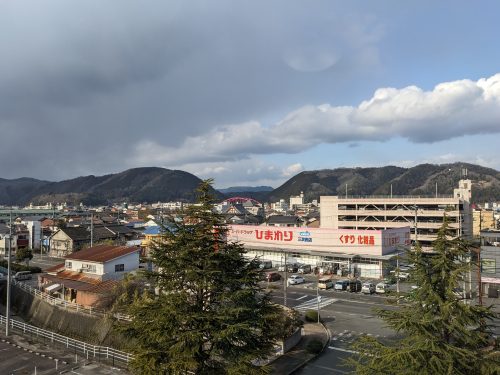
Miyoshi Station can be reached either by the JR Geibi Line or a highway bus from Hiroshima Station; the train is shorter and cheaper, but the highway bus is (in my humble opinion) a more comfortable ride and makes more sense when one is based out of downtown Hiroshima. An hour and forty-five minutes later, I found myself at Miyoshi Station, where the weather was nippier but the air was crisper. While the main points of interest in central Miyoshi are walkable, they aren’t exactly near the station and there’s the Kururun bus that runs throughout town that saves people time and energy.
Miyoshi’s Hondori
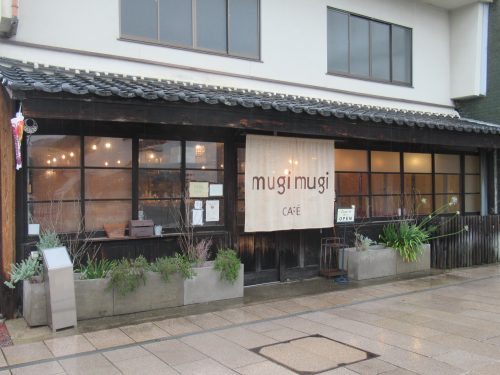
I boarded the next Kururun bus, paid a flat fare of ¥200, and in less than ten minutes, I pressed the buzzer to alight at Miyoshi Hondori, right in front of the Yotte-ne supermarket. The ground was wet as it had just rained (and it was fixing to rain again soon), but the sandstone tiles of this road still looked pretty, seemingly inviting all visitors to check out the quaint businesses on it. One of the first businesses visitors may lay their eyes on is the mugi mugi CAFÉ, a cute bakery with a café space specializing in baked goods made from fresh, local ingredients. There’s lots of English and French written on the signs inside the store, but as it is a Japanese bakery after all, I did spot spelling mistakes in both languages, which momentarily shattered the illusion for me. I bought some bread to take home and went on my merry way looking for a proper restaurant dishing out lunch.

Such a lunch was indeed found near the north end of Hondori, in a shop with a blue front curtain called Tatsuzen (たつ膳). The Japanese word tatsu may refer to a dragon, and if so, with this year being the Year of the Dragon, it might have been destiny that I discovered this restaurant. Tatsuzen has a lunch special that seems to change on a daily basis: that day, I was served fried horse mackerel with beef and tofu sukiyaki. That was accompanied by a raw egg for dipping, steamed white rice, a bowl of miso soup, some Japanese pickles, a side of stewed vegetables, a fresh salad, and a cup of tea. It sounds like a lot of food, but such an amount is what I need to keep going throughout my day, and after downing the last of my lunch, I was finally ready to tour the immediate area.
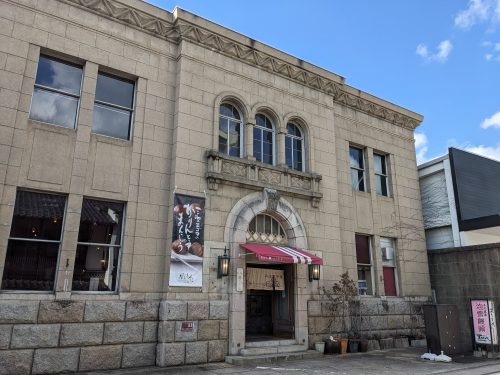
Another establishment of interest on Miyoshi’s Hondori is a confectionary named Fukisha (風季舎), located just south of the Yotte-ne supermarket. There is an eat-in space, but most customers simply buy their snacks and sweets to enjoy at home. Fukisha sports a grandiose, old-timey exterior and interior, so tourists should come even if they don’t wish to buy anything (but they really should buy something because everything here is delicious). One of their most sought-after products is the Awayuki Manju (泡雪まんじゅう – “bubble snow bun”), which tastes less like a bun and more like a sugary marshmallow filled with the quintessentially Japanese azuki bean filling. They sell those in bulk because they sell like hotcakes, but yours truly only bought one to try out. I spent more time inside this store than I should have, debating whether to buy this snack or that snack for the road, but later decided on some big rice crackers for a salty contrast to the usual saccharine products touted by advertisements.
Hundred-Demon Night Parade
One of the must-sees of Miyoshi is the Mononoke Museum, which is a six-minute walk from where I had lunch. Seeing as I visited on Setsubun (February 3rd) and it was about to rain, there was no better place to be that afternoon than indoors looking at a collection of yokai-inspired artwork. In addition to scroll paintings, jewelry, and plastic models depicting these fictitious yokai (demons, ghosts, and fairies, et cetera from Japanese folk tales), there were some creepier things on display, some skulls that allegedly belonged to yokai.
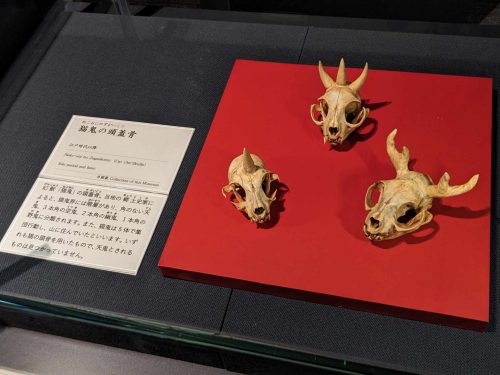
Alas, not everything inside this museum is old, for there were also a couple of touch-activated displays that are geared toward and popular with children. This digital remastering of a handscroll painting “Night Parade of One Hundred Demons” brings yokai to life on a white panel. Guests need only hover their hand over a demon, and it disappears from the panel before reappearing larger on the wall.
Speaking of demonic technology, TeamLab has also set up their own corner in the back of the museum. Here, visitors can choose from a variety of character coloring pages which can be colored in and brought to life. They had a human boy and human girl, as well as a few demon options to choose from; I went with a kappa, a water imp with a penchant for raw cucumbers.
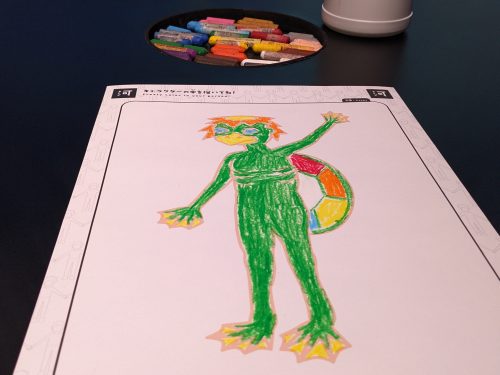
I first sat at one of several tables, each of which had a bunch of crayons in the center, and started fiercely but meticulously coloring. After giving my kappa a rainbow shell and orange hair, I gave my sheet to the employee, who ran it through a machine. I then busted out my camera to capture my own critter spawning on the big screen to interact with existing humans and demons in this digital night parade, in which the characters talked, laughed, and occasionally danced in unison.
Besides that, there was also an interactive play table in the same room that employed the same projection mapping technology seen in the digital scroll painting earlier. Visitors can pick up and place the physical objects anywhere on the table, and the projected characters and elements on the table will interact with it. The addition of rain, lightning, and random food popping up added to the entertainment.
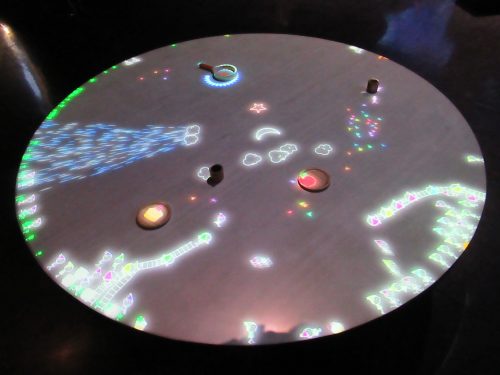
Moment of Joy: Lucky Setsubun
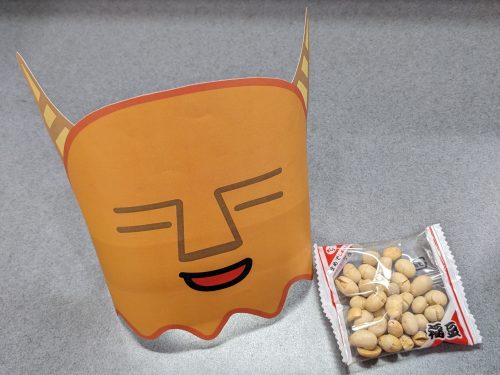
The Miyoshi Mononoke Museum advertised on their website that the first 30 parties to buy tickets on Setsubun would receive a free demon-themed fun pack for kids, which included a cute paper demon mask, some toasted soybeans to supposedly throw at the demon mask to ward off bad luck, a demon-themed coloring page different from what TeamLab provides, and a Mononoke Museum aluminum pin badge. As I had planned to visit the museum after lunch, I thought I wasn’t going to be one of those lucky thirty, but I was in for a fortunate surprise after purchasing my ticket at the counter. Externally, I kept my composure as the lady handed me the Miyoshi Mononoke Museum Setsubun fun pack, but my inner child was giddily thanking my lucky stars for this freebie! The above items came in handy over the coming days when it came time to observe Setsubun and entertain kids with not-so-scary demonic objects.
Setsubun Dinner
After concluding my visit to the Miyoshi Mononoke Museum, I pondered where to grab sushi rolls to eat, as per the Setsubun custom. Naturally, my mind drifted to the Yotte-ne supermarket where I got off the bus, and immediately started walking back to whence I came. It was late afternoon and ehomaki (恵方巻 – “lucky direction rolls”) were marked down, so I nabbed a fresh raw seafood roll and a kara-age mayonnaise roll for the road.
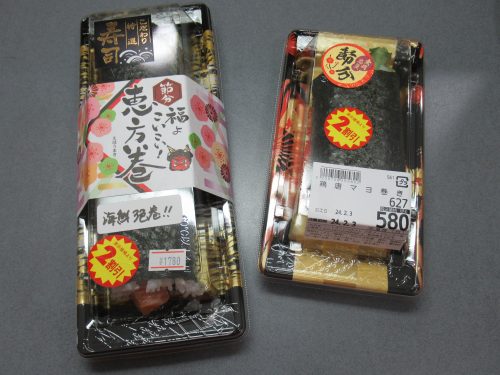
It was raining once again when I was walking to the supermarket, and that rain only got more intense when I left so I was anxious about how I would get back to Miyoshi Station in time. I approached the bus stop hoping that there would be a bus rolling by soon, and not too long after, the Kururun bus came to the rescue to drop me off in front of Miyoshi Station! Now all that was left was to go home and enjoy my ehomaki in accordance with Setsubun tradition.
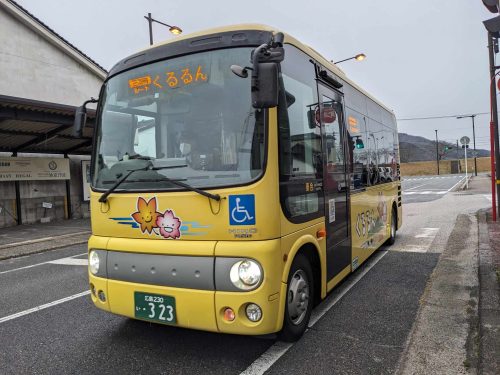
Ehomaki are typically uncut sushi rolls that folks eat with both hands in one go, but they ought to do so silently while facing the lucky direction, which changes year after year. This year’s lucky direction was east-northeast, which I found using the compass application on my smartphone. Using a compass isn’t a tradition and Japanese people usually just estimate the direction they face while eating ehomaki; when I tell them I use a compass to pinpoint the lucky direction right down to the degree, they tell me I’m overdoing it. Two fat sushi rolls combined were followed by three rice crackers I had bought from Fukisha and a hot cup of green tea I brewed myself. I deliberately chose three flavors that contrasted greatly with each other as well as the tea; from right to left, they were seaweed, sweet soy sauce, and granular sugar-flavored. Finally, I ate the free toasted soybeans I got from the Miyoshi Mononoke Museum that afternoon. According to tradition, one is supposed to eat a number of beans equal to one’s age, plus one more to account for the year to come, and in my case, the number of beans in the package was exactly the number of beans I was supposed to eat!
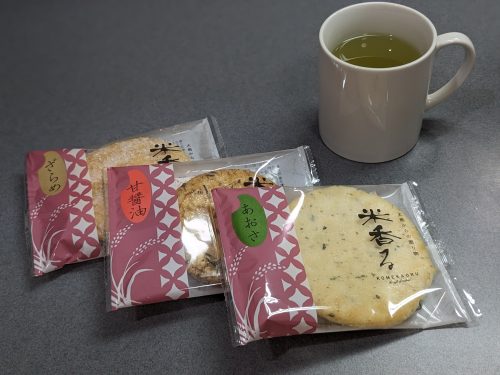
More Piping Hot Meals
There are other wonderful eateries in Miyoshi worth mentioning, and though they aren’t on Miyoshi’s Hondori, they are still situated in convenient parts of town depending on what a tourist is here to see. I visited Miyoshi again the week after Setsubun to try some more local food and snap some photos in better weather, and the first restaurant I wish to recommend is Goku (悟空), a reputable Chinese restaurant just a five-minute walk away from Miyoshi Station. It just so happens that Chinese New Year in 2024 fell on the 10th of February, which explains why I was in the mood for Chinese cuisine. The owner may have been inspired by the Chinese story Journey to the West (西遊記) or the Dragon Ball manga series, but most likely both since the menu was filled with Chinese food items with a Japanese twist and vice versa.

Anyhow, one of the must-tries is the Chinese-style katsu-don, which is just a regular katsu-don (fried pork cutlet rice bowl) topped with an egg-and-vegetable ankake sauce (starchy soup made with kudzu flour). It’s basically a fusion of chukadon (中華丼 – “Chinese rice bowl”) and katsu-don and described as a blend of Chinese and Japanese, but it really is Japanese through and through. Ankake sauce may be marketed as Chinese because it was influenced by Chinese cuisine, but chukadon is exclusively a Japanese recipe (they don’t eat the stuff in Chinese-speaking countries). Calling chukadon Chinese food would be the equivalent of calling katsu-don European just because the fried pork cutlet bears a resemblance to German Schnitzel. All in all, the picture above depicts a Japanized European recipe with a Chinese-inspired Japanese sauce topping, paired with a bowl of miso soup (so Japanese!), but if you think about it any harder your head might explode. Regardless, the meal was hearty and scrumptious, thus I advise any tourist to stop by for lunch upon arrival at Miyoshi Station or in the middle of sightseeing to kill time before a nighttime event.
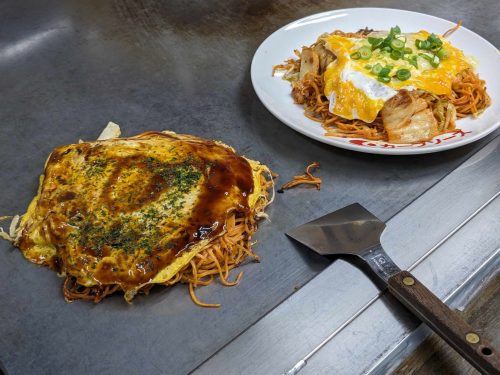
The second restaurant not on Miyoshi Hondori that’s worth checking out would be Horaiya (宝来屋), a small diner specializing in okonomiyaki and yakisoba. Miyoshi is already well-known for its red, spicy soba noodles, and Horaiya makes its Hiroshima-style okonomiyaki with those exact noodles. The restaurant interior exudes a homey atmosphere which allows customers to casually converse with the chef as he makes everyone’s food, which warms the soul from being piping hot and having a sharp kick of spice (I got my red yakisoba with kimchi mixed in for double piquancy). Reservations for dinner are not required but highly recommended since the locals clamor for a seat at the counter, and while I didn’t make a reservation per se, calling ahead to confirm the seating situation was a smart move on my part. Horaiya’s location by Miyoshi’s Itsukushima Shrine makes it an ideal location for dinner before or after attending the Nagoshi no Oharae Festival or taking part in a nocturnal cormorant boat tour in the summer, but even outside of that season, Horaiya is a tried-and-true choice that’s only fifteen minutes away from Miyoshi Station on foot.
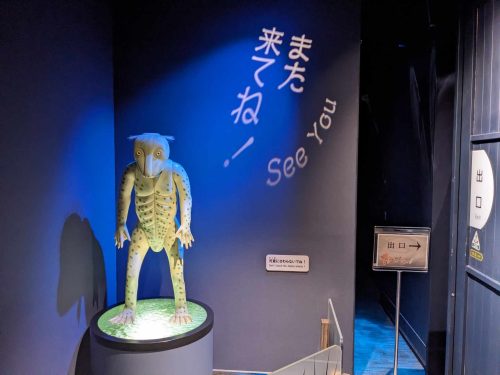
Being able to say so much about a small town I visited for two days is a sign that Miyoshi remains a valid tourist destination even in the bleak winter. Some of the most charming stores, restaurants, and museums in all of Hiroshima Prefecture are located here, with some even being endorsed in local guidebooks. On behalf of the hundreds of demons in the legendary night parade, this kappa from the Miyoshi Mononoke Museum would like to wish all tourists a devilishly grand time when coming over, whether it’s for fruit farms, local lore, fine wine, or something more. Come whatever season or weather, little old Miyoshi will provide an experience so charming it just might scare you.
Written by the Joy in Hiroshima Team
